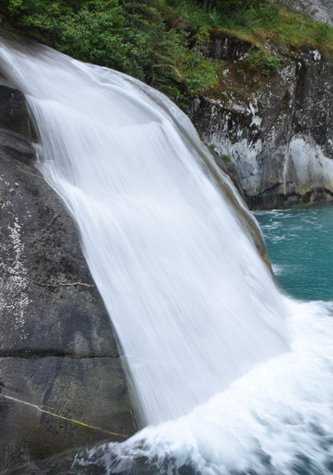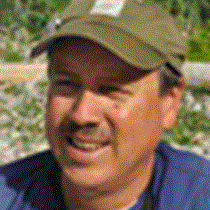Ice. Pure, beautiful, blue ice. As we awoke this morning, we were once again in the presence of floating icebergs, indicating our proximity to tidewater glaciers. National Geographic Sea Lion had entered Tracy Arm in the early morning by crossing the fjord’s shallow terminal moraine, which is a pile of debris that was produced during the Ice Age when the glacier was at its furthest extent.
Tracy Arm is a narrow and spectacular fjord that averages only a mile in width along its entire 26-mile length. Sheer granitic cliffs towered above us and we could see abundant evidence that the valley had been carved by glacial activity, later to be flooded by the sea. The clear blue color of many of the icebergs made them look like precious gemstones and some icebergs even appeared to have been sculpted at the hand of an expert ice-carver. Against the sheer, glacially-polished cliffs we marveled at the classic signs of glaciation: glacial striations, bowl-shaped cirques, U-shaped valleys, and hanging valleys. We moved in close to a waterfall to take in the beautiful sight.
Our morning activity was ice kayaking in the fjord directly from the ship. It was a great opportunity to paddle on our own and inspect the icebergs, shoreline, towering cliffs, and waterfalls close-up. Some of us even got to see icebergs split apart, roll over, and break into smaller pieces.
After lunch, we traveled further up the fjord toward the glaciers. In the upper part of the fjord are two tidewater glaciers (Sawyer Glacier and South Sawyer Glacier), which were joined as recently as 1880. We found an increasing number of icebergs in the upper part of the fjord and the ship worked its way carefully through the large pieces of floating ice.
We traveled as far as we could and then the inflatable boats were launched that allowed us to travel slowly through the ice to reach the fjord’s upper reaches to observe the face of South Sawyer Glacier. As we approached to within a half mile of the 200-foot-high face of this tidewater glacier, we were impressed by the deep crevasses and blue ice. In comparing pictures of the glacier taken several years ago as well as the trimline of recent vegetation, it was obvious that the glacier had both thinned and retreated dramatically. Curious harbor seals in the water watched our every move. Some of the inflatable boats were visited by a friendly pod of bow-riding harbor porpoises that were close enough to touch! Meanwhile, those of us on board were treated to a large calving event at Sawyer Glacier.
Once everyone was back on board, National Geographic Sea Lion exited out of the glacially-carved fjord during the guest slide show. During the captain’s farewell dinner, we began cruising Stephens Passage toward Juneau, our port of disembarkation and the end of a fabulous week’s voyage. Emotions flowed strongly as we bid this great land one last farewell—at least for now.







